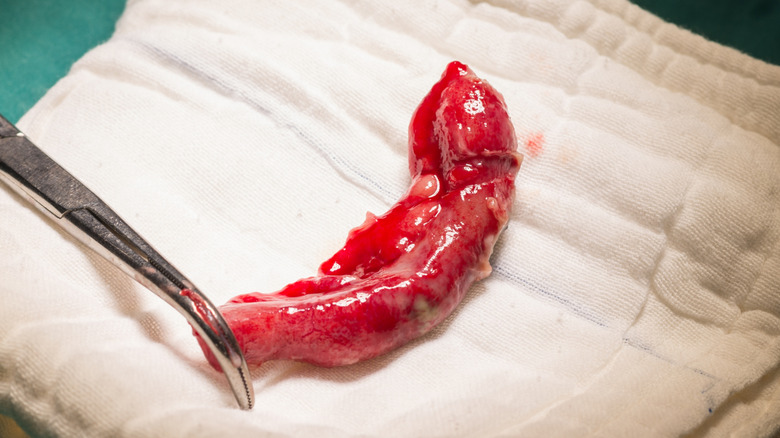Your Appendix May Not Be As Useless As You Think
As humans have evolved, some anatomical parts with functional roles in the body have become unfunctional and are often referred to as vestigial organs or structures. Some are believed to be a physiological adaptation — one of the three types of environmental adaptations, in fact — but in general, these biological features aren't essential for survival like they once were. Some examples include body hair, ear muscles, the tailbone, and the appendix. However, researchers are starting to find out that some of these believed "useless" organs aren't so useless after all, and the appendix is one of them.
Like with the thymus — a "useless" organ that's more important to your health than you thought — the appendix might actually serve multiple purposes in the body. One of its functions could be to produce endocrine cells in a fetus that make molecules the body needs for regulating homeostasis, which is how it maintains its internal systems — such as oxygen and temperature levels. Another potential purpose involves exposing white blood cells (leukocytes) to antigens (substances that stimulate a response from the immune system) in the gastrointestinal tract during the first 30 years of life. As a result, the immune system creates antibodies to rebalance gut-related immune reactions.
The most interesting of the possible functions of the appendix, though, is as a safe haven for good flora in the gut, which is useful throughout life — not just a certain amount of years. When you have diarrhea, for instance, the good bacteria in your microbiome get flushed out. Researchers hypothesize that the appendix stores beneficial (and other) gut bacteria to recolonize the colon, returning the microbiome to normal again after an illness. However, more studies are needed to confirm these theories.
Why so many people have their appendixes removed
If the appendix has such beneficial functions, why do so many people get them removed? Appendectomies — the procedural name for removing an appendix — are a common solution for appendicitis, the term for an inflamed appendix. This inflammation is usually the result of a bacterial infection that may have started in the stomach but spread to the organ. On the other hand, it might be the result of a blockage in the lumen (or the lining of the appendix). Without swift treatment, the swollen and pus-filled organ could break open or burst, freely releasing the bacteria and spreading the infection into the abdomen.
Most appendectomies today are performed through laparoscopy, a minimally invasive form of surgery, to prevent the infection from escaping. It's also the go-to treatment when patients are diagnosed with appendix cancer. The procedure is simple because of where the appendix is located — at the end of the cecum. And, removing it doesn't affect how the cecum functions to move digested food waste from the small intestine to the ascending colon. In non-acute cases, though, many doctors have shifted from surgery since antibiotics have become effective at treating appendicitis and reducing the risk for complications, such as colon cancer.

